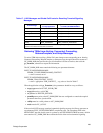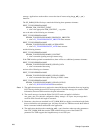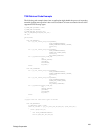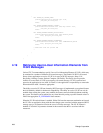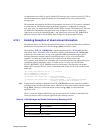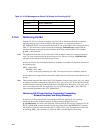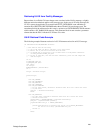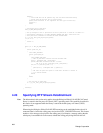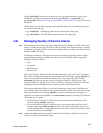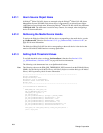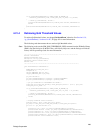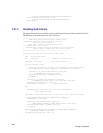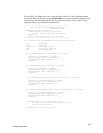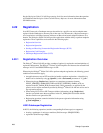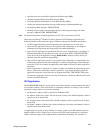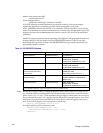263
Dialogic Corporation
The gc_SetUserInfo( ) function can be used to specify call-related information such as coder
information and display information before issuing gc_CallAck( ), gc_AcceptCall( ) or
gc_AnswerCall( ). See Section 8.3.26, “gc_SetUserInfo( ) Variances for IP”, on page 487 for more
information.
On the called party side, RTP streaming can be established before any of the following functions
are issued to process the call:
• gc_AcceptCall( ) – SIP Ringing (180) message returned to the calling party
• gc_AnswerCall( ) – SIP OK (200) message returned to the calling party
4.21 Managing Quality of Service Alarms
Note: The information in this section only applies when the Dialogic
®
Global Call API IP Call Control
library is started in the first party call control (1PCC) operating mode. When the library is started in
the third party call control (3PCC) operating mode, QoS alarms are configured and handled via the
IP Media (IPML) API library.
The Dialogic
®
Global Call API supports the setting and retrieving of Quality of Service (QoS)
thresholds and the handling of a QoS alarm when it occurs. The QoS thresholds supported by
Dialogic
®
Global Call API are:
• jitter
• lost packets
• RTCP inactivity
• RTP inactivity
When using Dialogic
®
Global Call API with other technologies (such as E1 CAS or T1 Robbed
Bit), alarms are managed and reported on the network device. For example, when gc_OpenEx( ) is
issued, specifying both a network device (dtiB1T1) and a voice device (dxxxB1C1) in the
devicename parameter, the function retrieves a Dialogic
®
Global Call API line device. This
Dialogic
®
Global Call API line device can be used directly in Dialogic
®
Global Call API Alarm
Management System (GCAMS) functions to manage alarms on the network device.
When using the Dialogic
®
Global Call API with IP technology, alarms such as QoS alarms are
more directly related to the media processing and are therefore reported on the media device rather
than on the network device. When gc_OpenEx( ) is issued, specifying both a network device
(iptB1T1) and a media device (ipmB1C1) in the devicename parameter, two Dialogic
®
Global Call
API line devices are created:
• The first Dialogic
®
Global Call API line device corresponds to the network device and is
retrieved in the gc_OpenEx( ) function.
• The second Dialogic
®
Global Call API line device corresponds to the media device and is
retrieved using the gc_GetResourceH( ) function. This is the line device that must be used
with GCAMS functions to manage QoS alarms. See the Global Call API Programming Guide
for more information about GCAMS.
Note: Applications must include the gcipmlib.h header file before Dialogic
®
Global Call API can be
used to set or retrieve QoS threshold values.



